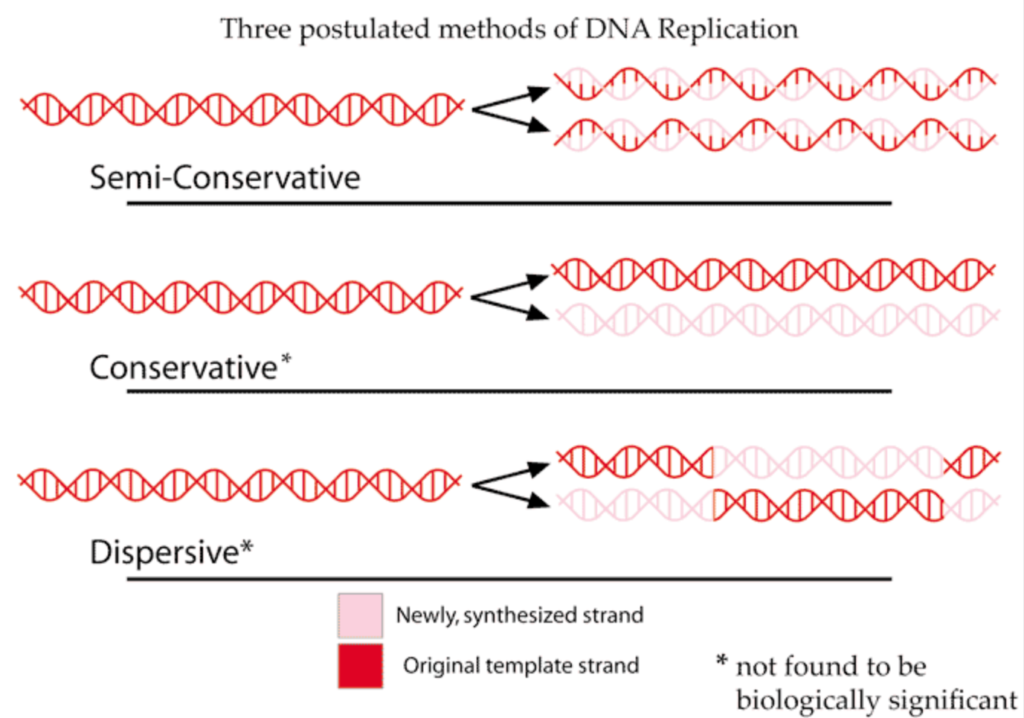DNA replication is a fundamental process by which a cell duplicates its DNA before cell division, ensuring that each daughter cell inherits an identical copy of the DNA. The semi-conservative model of DNA replication is the accepted mechanism by which DNA replication occurs. This model was proposed by Watson and Crick in 1953 and confirmed experimentally by Meselson and Stahl in 1958. Below is a detailed note on the semi-conservative model of DNA replication.
Key Steps in DNA Replication
1. Initiation:
Origin of Replication: DNA replication begins at specific locations in the genome called origins of replication. Prokaryotes typically have a single origin of replication, while eukaryotes have multiple origins to speed up the process.
Helicase: An enzyme called helicase unwinds the double helix by breaking the hydrogen bonds between the complementary base pairs, creating a replication fork.
Single-Strand Binding Proteins (SSBs): These proteins bind to the separated DNA strands to prevent them from re-annealing or forming secondary structures.
2. Primer Synthesis:
Primase: This enzyme synthesizes a short RNA primer complementary to the DNA template strand. The primer provides a starting point for DNA synthesis because DNA polymerase cannot initiate synthesis de novo.

3. Elongation:
DNA Polymerase: The main enzyme involved in DNA replication. DNA polymerase adds nucleotides to the 3′ end of the primer, synthesizing the new DNA strand in a 5′ to 3′ direction. There are different types of DNA polymerases in prokaryotes and eukaryotes (e.g., DNA polymerase III in prokaryotes and DNA polymerase δ and ε in eukaryotes).
Leading Strand Synthesis: The leading strand is synthesized continuously in the direction of the replication fork.
Lagging Strand Synthesis: The lagging strand is synthesized discontinuously in short fragments called Okazaki fragments, as it is oriented in the opposite direction to the replication fork movement. Each fragment requires a new RNA primer.
4. Primer Removal and Replacement:
Exonuclease Activity: In prokaryotes, DNA polymerase I removes the RNA primers and fills in the gaps with DNA. In eukaryotes, RNase H removes the RNA primers, and DNA polymerase δ fills in the gaps.
DNA Ligase: This enzyme seals the nicks between Okazaki fragments, forming a continuous DNA strand by creating phosphodiester bonds.
5. Termination:
Replication proceeds until the entire molecule is replicated. In prokaryotes, this often involves specific termination sequences. In eukaryotes, replication ends when replication forks meet, and telomeres play a role in completing replication at chromosome ends.
Key Features of Semi-Conservative Replication
Semi-Conservative Nature: Each daughter DNA molecule consists of one parental strand and one newly synthesized strand. This ensures the genetic information is conserved across generations.
Bidirectional Replication: Replication usually proceeds in both directions from each origin of replication, forming two replication forks.
Proofreading and Error Correction: DNA polymerases have proofreading activity, ensuring high fidelity in DNA replication by correcting misincorporated nucleotides.
Experimental Evidence for Semi-Conservative Replication:
Meselson-Stahl Experiment (1958): This classic experiment provided definitive evidence for the semi-conservative mechanism.
Method: E. coli was grown in a medium containing heavy nitrogen (15N) and then switched to a medium with light nitrogen (14N). DNA was extracted at various time points and subjected to density gradient centrifugation.
Results: After one round of replication, DNA consisted of hybrid (15N-14N) molecules, indicating each daughter molecule had one old (15N) and one new (14N) strand. After the second round, there were both hybrid and light (14N-14N) DNA molecules, confirming the semi-conservative model.
Significance
Genetic Fidelity: The semi-conservative mechanism ensures accurate transmission of genetic information during cell division, which is crucial for maintaining the integrity of the genome.
Basis for Genetic Inheritance: This model underlies our understanding of genetic inheritance, mutation, and recombination, forming the foundation for molecular biology and genetics.
Understanding the semi-conservative model of DNA replication provides insights into the molecular basis of heredity and the mechanisms that preserve genetic continuity and stability.
Visit to: Pharmacareerinsider.com

